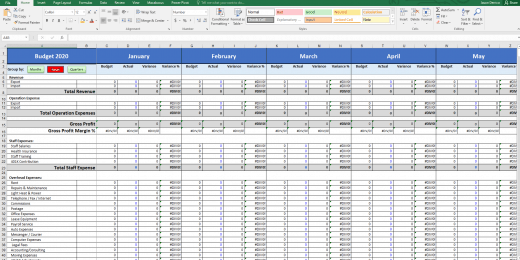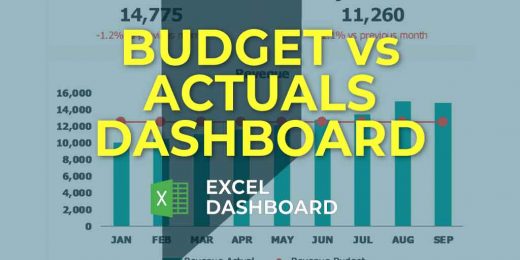Budget Versus Actual Variance Calculation: Unlocking the Secrets for Success

Budget versus actual variance calculation is crucial for financial success. It assesses how budgeted figures compare to actual expenditures or revenue.
Mastering the art of budget versus actual variance calculation can significantly enhance a company’s financial performance by providing insights into where the business stands in terms of meeting its financial objectives. By comparing budgeted figures against real-world results, businesses can pinpoint discrepancies, understand financial health, and make informed decisions moving forward.
This practice not only highlights areas of over or underperformance but also serves as a platform for refining future budgets. The key to success lies in identifying variances promptly and adjusting strategies accordingly, ensuring the organization remains on the path to achieving its fiscal goals. With a clear, analytical approach to these variances, companies can unlock a deeper understanding of their finances, fostering a proactive environment for growth and efficiency.
Budget Variance Analysis Significance
Budget variance analysis plays a crucial role in a company’s financial health. By comparing what was planned against what actually happened, businesses can identify areas that need attention. This analysis helps uncover the secrets behind financial figures, guiding companies towards greater efficiency and profitability.
Key To Financial Management
Effective financial management hinges on understanding the differences between budget expectations and actual results. Knowing where the numbers deviate allows businesses to:
- Control costs by pinpointing overruns.
- Adjust strategies to allocate resources better.
- Make informed decisions for future planning.
This level of detail is essential for maintaining the financial stability of a business.
Predictive Tool For Business Health
Regular budget variance analysis acts as a predictive tool, indicating the overall health of a business. It helps in:
- Anticipating financial trends.
- Detecting potential issues before they escalate.
- Identifying successful areas that merit more investment.
This predictive capability is vital for a business’s long-term success.
Foundations Of Budgeting
Budgeting acts as a financial blueprint for businesses and individuals alike. It forecasts revenues and expenses over a specific period. Crafting a budget helps in planning for future financial needs. Comparing the budget versus actual outcomes reveals variances that can lead to insightful decisions for success.
Determinants Of A Sound Budget
Several factors contribute to creating a robust budget that stands the test of time:
- Accurate historical data: analyzes past financial performance.
- Realistic assumptions: forms the basis of future projections.
- Defined goals: sets clear targets for revenue and spending.
- Flexibility: allows adjustments for unexpected changes.
Core Principles In Budgeting
To ensure the effectiveness of a budget, the following core principles must be adhered to:
- Consistency: apply the same standards across the budgeting process.
- Clarity: make the budget understandable to all stakeholders.
- Accountability: assign responsibility for budgetary elements.
- Monitoring: review budget performance regularly.
| Principle | Importance |
|---|---|
| Consistency | Ensures comparable and reliable data |
| Clarity | Fosters informed decision-making |
| Accountability | Drives goal-oriented actions |
| Monitoring | Enables proactive financial management |
Understanding Actuals
Unlocking the secrets for success in financial management lies within the grasp of Budget Versus Actual Variance Calculation. A critical component of this process is ‘Understanding Actuals’. Actuals refer to the real financial figures incurred by a business. Grasping the nature and relevance of these actual figures is pivotal for precise financial analysis and informed decision-making.
Nature Of Actual Financial Data
When dissecting financial performance, actual financial data serves as the cornerstone. This data represents the concrete financial transactions that a business has completed. Data integrity ensures accuracy for variance analysis. Consider the following aspects of actual financial data:
- Recorded transactions – Entries that reflect real monetary exchanges.
- Time-stamped – Actuals are logged when the financial event occurs.
- Unbiased truth – They show what has genuinely transpired, not projections.
- Audit trail – Each entry can be traced back for verification purposes.
Relevance Of Actuals In Analysis
The significance of actuals in financial scrutiny is immense. They serve as the litmus test against the speculated financial road map laid out by the budget. Key points to understand about the relevance include:
- Performance assessment – By comparing actuals against the budget, one can determine variances that highlight performance levels.
- Corrective action – Identifying deviations early allows businesses to take corrective measures swiftly.
- Future budgeting – Learning from past actuals can refine future budget forecasts.
- Strategic decisions – Actuals inform stakeholders about the financial health and aid in strategic planning.
Diving Into Variance Calculation
Understanding budget versus actual variance is crucial for a company’s financial health. It highlights where the business stands in terms of financial planning and execution. Companies that excel in this area often reap benefits like improved financial control and strategic decision-making. This exploration provides a detailed insight into the formula and different types of variances that businesses commonly encounter.
Basic Variance Formula
The core of variance analysis lies in a simple equation. To calculate any variance, subtract the ‘planned amount’ from the ‘actual amount’. This difference offers a clear picture of financial performance. It helps determine if a company is over or under-spending in relation to its plan.
Variance = Actual Amount - Planned Amount
When the result is positive, it’s a favorable variance, meaning the business spent less than anticipated. A negative result indicates an unfavorable variance, implying overspending.
Types Of Variances Encountered
Different variances reflect various aspects of a business’s health. Here’s a breakdown of the most common types:
- Sales Variance: Compares actual sales to forecasted sales.
- Volume Variance: Looks at the difference in actual quantity sold versus expected.
- Price Variance: Analyzes the difference between the actual price and the standard price.
- Cost Variance: Focuses on the difference in actual vs. planned costs.
- Efficiency Variance: Examines the use of resources against the plan.
Each variance offers distinct insights and, when combined, can paint a comprehensive picture of where a company can either save money or optimize revenue.
Positive And Negative Variance Implications
An essential tool in business management is the Budget Versus Actual Variance Calculation. This analysis helps to understand where financial performance diverges from the planned budget, revealing insights into operational effectiveness and resource utilization. Each variance holds specific implications, highlighting areas that exceed expectations and others that call for immediate attention and adjustment. Breaking down these variances is crucial to steering a business toward success.
Analyzing Favorable Variances
Favorable variances emerge when actual results outperform the budget. These variances are not merely numbers; they represent successful strategies and operational efficiency. Such experiences can inform future business decisions, improve resource allocation, and promote sustainable business practices.
- Increased revenues: Higher-than-expected sales figures can indicate a strong market position.
- Lower costs: Spending less than planned can spotlight efficiency in production or procurement.
- Better margins: A combination of higher revenues and lower costs enhances overall profitability.
By analyzing why these favorable variances occurred, businesses can replicate their successful tactics.
Consequences Of Adverse Variances
Adverse variances signal a miss in budget targets. They can stem from various factors such as increased costs, lower sales volume, or external market changes. Recognizing these areas is critical for prompt corrective actions.
- Dip in revenue: Signals potential issues with product demand or pricing strategies.
- Rise in expenses: Indicates potential operational inefficiencies or cost control issues.
- Profit shortfall: Implies that overall business performance is not meeting the set expectations.
The study of negative variances directs attention to underlying problems demanding swift action to mitigate risks and update strategies.
In summary, positive variances denote celebration and learning, while negative variances serve as red flags that require introspection and change. Regular variance analysis plays a pivotal role in achieving a company’s financial and operational goals.
Data Accuracy In Variance Analysis
The success of any budget versus actual variance calculation lies in the precision of your data. High-quality variance analysis demands impeccable data accuracy. This ensures you gain true insights into your financial performance. Thus, leading to informed decision-making. Let’s dive into the core of maintaining data accuracy.
Ensuring Data Integrity
Data integrity is the backbone of variance analysis. Accurate data allows for a fair comparison between budget forecasts and actual results. This leads to reliable conclusions.
- Data Consistency: Ensure all sources report data in the same way. This makes comparisons meaningful.
- Timeliness: Use the most current data to avoid outdated comparisons.
- Error Checking: Implement checks to catch and correct errors. This ensures data quality.
Challenges In Data Collection
Gathering precise data comes with challenges. Recognizing these barriers can help in crafting strategies to overcome them.
- Disparate Systems: Different systems may not communicate well. This can create discrepancies.
- Human Error: Mistakes in data entry can skew results. Rigorous training and checks can reduce errors.
- Complex Calculations: Sometimes, data requires complex processing. Ensure accurate formulas are in place.
Role Of Technology In Variance Analysis
Imagine a world where numbers tell a story without a sweat. Technology redefines variance analysis, turning complex data into clear paths for business decisions. It’s not just about numbers; it’s about unlocking the secrets to success.
Software Solutions for Variance Analytics
Software Solutions For Variance Analytics
A treasure trove of software awaits to simplify variance analysis. Tools and platforms swiftly compare budget against actuals. Insights are now at your fingertips.
- Real-time analysis: Instant measures of financial health
- Visual dashboards: Numbers become easy-to-digest charts
- Custom alerts: Notifications for deviations, large or small
Choosing the right software is crucial. Must-haves include:
| Feature | Description |
|---|---|
| User-Friendly | Simple to navigate and use |
| Integrative Capacity | Connects with existing systems |
| Scalability | Grows with your business needs |
Automating Data Collection and Reporting
Automating Data Collection And Reporting
Gone are the days of manual data entry. Automation is king in timely, error-free reporting. Technology simplifies gathering and organizing data. Say goodbye to late nights with spreadsheets. Say hello to precision and speed.
- Data Accuracy: Reduce human errors
- Consistency: Same methods, same high-quality results
- Efficiency: Free up time for strategic tasks
Employing tech for variance analysis is not just about efficiency; it’s about giving businesses the upper hand. Tools that automate foster a proactive rather than reactive approach to financial management.
Best Practices For Continuous Improvement
Budget Versus Actual Variance Calculation is a critical part of financial analysis.
It allows organizations to understand their financial health.
Businesses aim for precision, but unexpected events can make this hard.
Continuous improvement practices are the tools that help keep businesses on track.
These best practices are the secrets to unlocking success.
Benchmarking Against Industry Standards
Knowing where you stand against competitors is crucial.
Benchmarking is about comparing your results with peers.
It sheds light on areas needing improvement.
Begin with these steps:
- Identify Key Performance Indicators (KPIs): Select metrics relevant to your industry
- Gather Data: Collect information from industry reports and competitors
- Analyze: Compare your performance against this data
- Set Goals: Use findings to set realistic targets
Regular benchmarking keeps you ahead.
It ensures you are moving toward industry leadership.
Incorporating Feedback Loops
Feedback loops are systems that improve through recurring input.
In finance, this means learning from past variance analysis.
Here’s how to incorporate feedback loops effectively:
- Review past variances to prevent future ones
- Involve teams in creating actionable steps for improvement
- Update forecasts regularly based on actual outcomes
- Communicate findings clearly across the organization
These steps will build a culture that values feedback.
It will drive your business towards smarter financial planning.
Frequently Asked Questions
How Do You Explain Variance Between Budget And Actual?
Variance between budget and actual reflects the differences in projected and actual financial performance. This occurs due to unexpected expenses, revenue shortfalls, or changes in market conditions. Understanding these variances helps in adjusting future budgets and strategies.
Why Is It A Good Idea To Compare Budgeted Figures Against Actual Figures?
Comparing budgeted figures against actuals is crucial for monitoring financial health. It helps identify variances, enables cost control, and facilitates informed decision-making for future planning.
How To Monitor Variance Between Actual And Budgeted Performance?
To monitor variance between actual and budgeted performance, implement these steps: 1. Regularly review financial statements. 2. Compare actual results with budget forecasts. 3. Analyze reasons for discrepancies. 4. Adjust strategies as needed. 5. Use software tools for real-time tracking.
Why Is It Important To Evaluate Variances Between What Has Been Budgeted And What Actually Was Expensed In The Budget Planning Process?
Evaluating budget variances is crucial to understand spending patterns, identify cost-control issues, and inform future budgeting decisions. This analysis helps improve financial accuracy and operational efficiency.
Conclusion
Mastering the art of calculating budget versus actual variance is crucial for any business. It empowers you to maintain financial health and make informed decisions. Embracing this skill can lead to improved efficiency and profitability. Start analyzing your financial performance today and steer your business toward greater success tomorrow.



















































